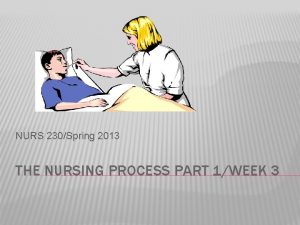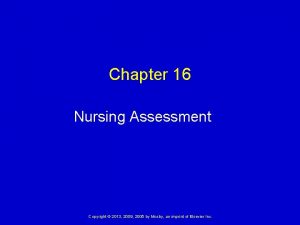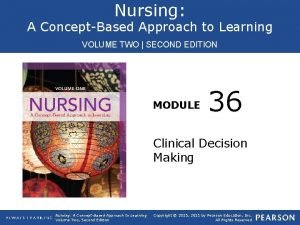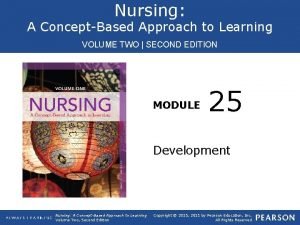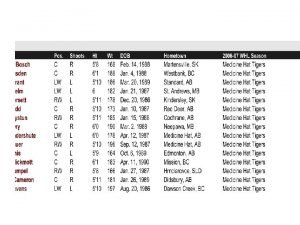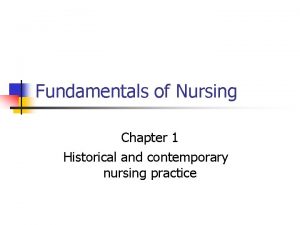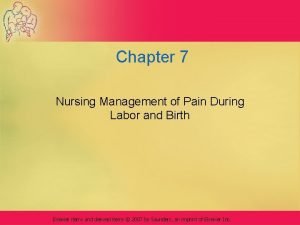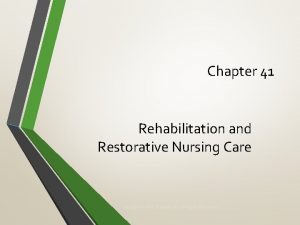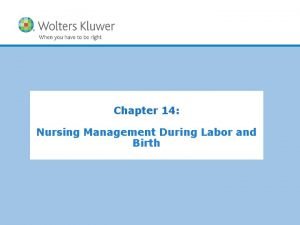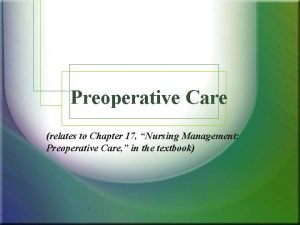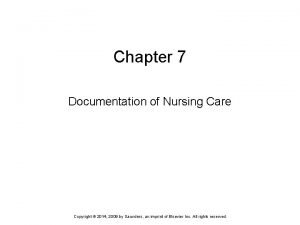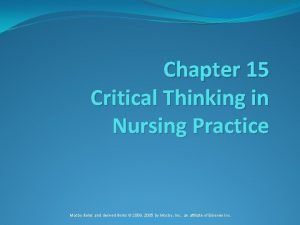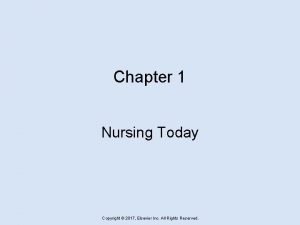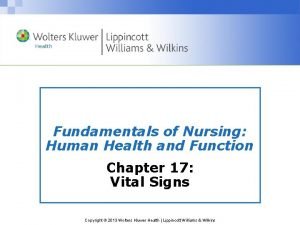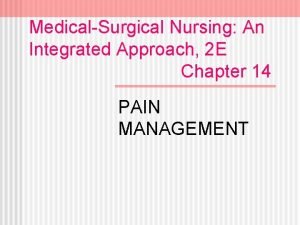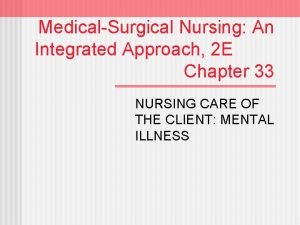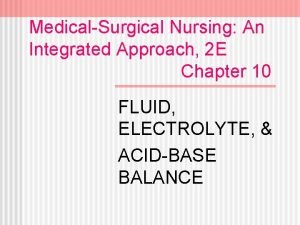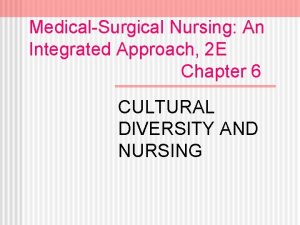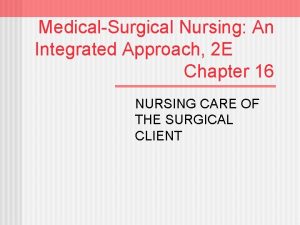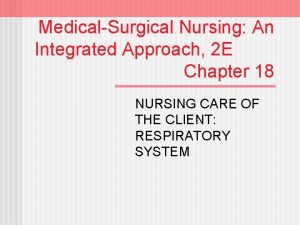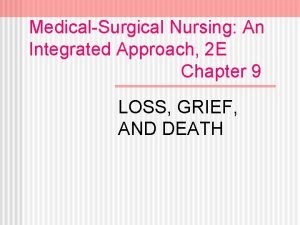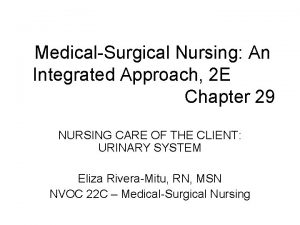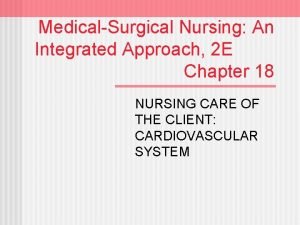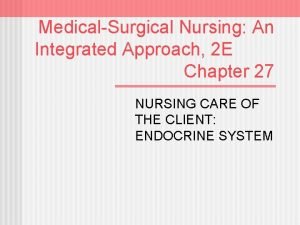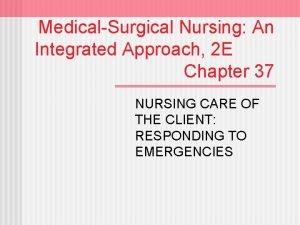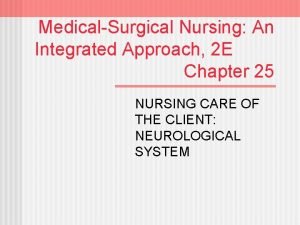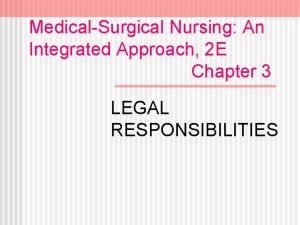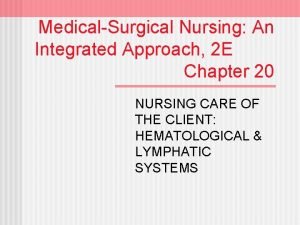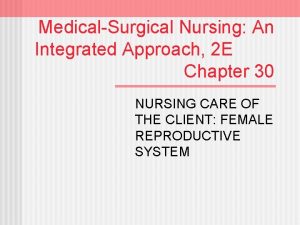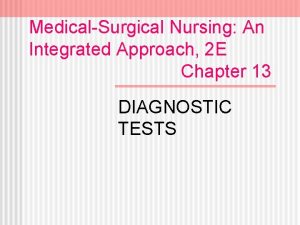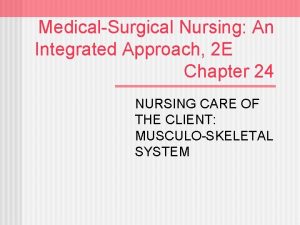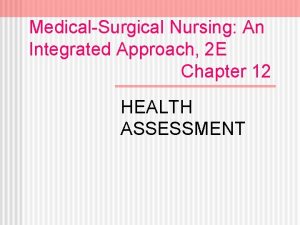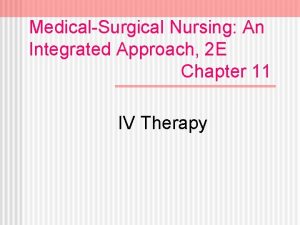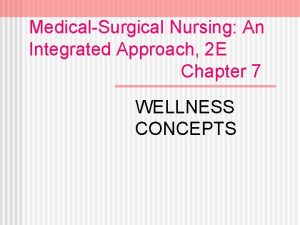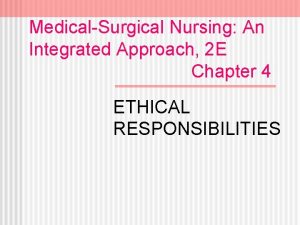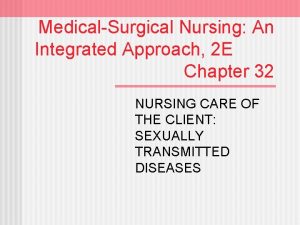MedicalSurgical Nursing An Integrated Approach 2 E Chapter































- Slides: 31

Medical-Surgical Nursing: An Integrated Approach, 2 E Chapter 35 NURSING CARE AND THE OLDER CLIENT

Gerontology n The study of the effects of normal aging and age-related diseases on human beings.

Demographic Profile of Older Adult Population Clinical delineation is 65 years of age or older. n Older-old adults are 85 or older. n By the year 2030, the number of older adults in the United States will reach 70. 2 million. n

Characteristics of the Older Adult Population Rapidly growing. n Although many stereotypes and myths are associated with aging, elders are in fact very diverse in their characteristics. n

Stereotyping Older Adults n Health professionals must be diligent in avoiding age prejudice, as believing stereotypes can influence interactions between older adults and caregivers.

Major Theories of Aging: Biological n n n Somatic Mutation Theory (Changes associated with aging are the result of decreased function and efficiency of cells and organs) Programmed Aging Theory (Genetic clock determines speed of aging) Cross-linkage, or Collagen, Theory (Loss of flexibility results in diminished functional motility) Immunity Theory (Diminishing of thymus results in impaired immunologic function) Stress Theory (Stress causes structural and chemical changes that eventually result in irreversible tissue damage).

Major Theories of Aging: Psychosocial n n n Activity Theory (Life satisfaction depends on maintaining an involvement with life by developing new interests, hobbies, roles, and relationships). Disengagement Theory (Decreased interaction between older person and others in the social system is inevitable, mutual, and acceptable to both the individual and society). Continuity Theory (Successful methods used throughout life for adapting and adjusting to life events are repeated. Traits, habits, values, associations, and goals remain stable, regardless of life changes).

Myths about Aging Senility is a result of aging. n Incontinence is a result of aging. n Older adults are no longer interested in sexuality. n Most people spend their last years in nursing homes. n All elderly persons are financially impoverished. n

Realities of Aging Dementia is disease-related, not agerelated. n Incontinence is not present among all aged. n Sexuality is a lifelong need. n 10% to 40% of elderly in the U. S. may spend some time in extended care facilities. n

Activities of Daily Living n Basic care activities that include: n n n n Mobility. Bathing. Hygiene. Grooming. Dressing. Eating. Toileting.

Exercise and the Older Adult Research indicates that high-intensity, progressive resistance training can improve muscle strength and muscle size in frail elderly clients. n Exercise programs should be individually planned and should take into account the client’s general health status, physiologic disorders (if present), physical environment, and other factors. n

Nutrition and the Older Adult Elders must follow a balanced diet, often with lowered intakes of sugar, caffeine, and sodium. n There are no universally accept dietary guidelines specific to older adults. n It is important that nurses be knowledgeable about community services designed to help older clients meet their nutritional needs. n

Strengths of Older Adults Physiologic changes may result in losses, causing impairments in communication, vision and learning, mobility, cognition, or psychosocial skills. n The strengths of each individual (including past coping skills) must be identified and utilized when planning care. n

Health Promotion and Disease Prevention Older adults must be alerted to means of preventing disease and reducing risks. n Being knowledgeable about self-care and participating in screening tests are important components of health maintenance. n

Polypharmacy n The problem of clients taking numerous prescription and over-the-counter medications for the same or various disease processes, with unknown consequences from the resulting combination of chemical compounds and cumulative side effects.

Physiologic Changes Associated with Aging: Overview n n n Respiratory System Cardiovascular System Gastrointestinal System Reproductive System: Female Reproductive System: Male n n n Endocrine System Musculoskeletal System Integumentary System Nervous System Urinary System Sensory Changes

Respiratory System: Changes n n n Muscles of respiration become less flexible. Decrease in functional capacity results in dyspnea on exertion or stress. Effectiveness of cough mechanism lessens, increasing risk of lung infection. n n Alveoli thicken and decrease in number and size. Structural changes in the skeleton can decrease diaphragmatic expansion.

Cardiovascular System: Changes n n n Cardiac output and recovery time decline. The heart requires more time to return to normal rate after a rate increase in response to activity. Heart rate slows. Blood flow to all organs decreases. n n Arterial elasticity decreases, causing increased rise in blood pressure. Veins dilate and superficial vessels become more prominent.

Gastrointestinal System: Changes n n Tooth enamel thins. Periodontal disease rate increases. Taste buds decrease in number, and saliva production diminishes. Effectiveness of the gag reflex lessens, resulting in increased risk of choking. n n Arterial elasticity decreases, causing increased rise in blood pressure. Veins dilate and superficial vessels become more prominent.

Reproductive System: Female: Changes n n n Estrogen production decreases with onset of menopause. Ovaries, uterus, and cervix decrease in size. Vagina shortens, narrows, becomes less elastic; vaginal lining thins. n n n Supporting musculature of the reproductive organs weakens, increasing risk of uterine prolapse. Breast tissue diminishes. Libido and the need for intimacy and companionship in older women remains unchanged.

Reproductive System: Male: Changes n n n Testosterone production decreases, resulting in decreased size of testicles. Impotency may occur. Although more time is require to obtain erection, the older man often finds hat he and his partner can enjoy longer periods of lovemaking prior to ejaculation. n n n Prostate gland may enlarge. Libido and need for intimacy and companionship remain unchanged in older males. Sperm count and viscosity of seminal fluid decrease.

Endocrine System: Changes Alterations occur in both the reception and the production of hormones. n Release of insulin by the beta cells of the pancreas slows, causing an increase in blood sugar. n Thyroid changes may lower the basal metabolic rate. n

Musculoskeletal System: Changes n Muscle mass and elasticity diminish, resulting in decreased strength, endurance, coordination, and increased reaction time. n Bone demineralization occurs, causing skeletal instability and shrinking of intervertebral disks. n Joints undergo degenerative changes, resulting in stiffness, pain, and loss of range of motion.

Integumentary System: Changes (i) n n n Subcutaneous tissue and elastin fibers diminish, causing skin to become thinner and less elastic. Hyperpigmentation or liver spots. Diminished secretions and moisturization. Body temperature regulation diminishes. Capillary blood flow decreases, resulting in slower wound healing. Blood flow decreases, especially to lower extremities.

Integumentary System: Changes (ii) n n n Vascular fragility causes senile purpura. Cutaneous sensitivity to pressure and temperature diminishes. Melanin production decreases, causing gray-white hair. Scalp, pubic, and axillary hair tin, and women display increased facial hair. Nail growth slows, nails become more brittle, and longitudinal nail ridges form.

Nervous System: Changes n n n Neurons in the brain decrease in number. Cerebral blood flow and oxygen utilization decrease. Time required to carry out motor and sensory tasks requiring speed, coordination, balance, and fine-motor hand movements increases. n n n Short-term memory may somewhat diminish without much change in long-term memory. Night sleep disturbances occur due to more frequent and longer wakeful periods. Deep-tendon reflexes decrease, although reflexes at the knees remain fairly intact.

Dementia An organic brain pathology characterized by losses in intellectual functioning. n The clinical manifestations associated with dementia are never considered normal aging changes. n

Urinary System: Changes n n n Nephrons in the kidneys decrease in number and function. Glomerular filtration decreases. Blood urea nitrogen increases. Sodium-conserving ability diminishes. Bladder capacity decreases. n n Renal function increases when the older client lies down. Bladder and perineal muscles weaken. Incidence of stress incontinence increases in older females. Prostate may enlarge in older males, causing urinary frequency and dribbling.

Sensory Changes: Vision n n The lens becomes less pliable and less able to increase its curvature in order to focus on near objects. Accommodation of pupil size decreases, resulting in both decreased adjustment to changes in lighting and decreased ability to tolerate glare. n n n Vitreous humor changes in consistency, causing blurred vision. Lacrimal glands secrete less fluids, causing dryness and itching. Lens yellows, causing distorted color perception.

Sensory Changes: Hearing n n n The pinna becomes less flexible, hair cells in inner ear stiffen and atrophy, and cerumen (earwax) increases. Number of neutrons in the cochlea decrease and blood supply lessens, causing degeneration. Presbycusis, the impairment of hearing in older adults, is often accompanied by a loss of tone discrimination.

Financing Elder Care in the 21 st Century Medicare n Medicaid n Omnibus Budget Reconciliation Act n Balanced Budget Act of 1997 n
 An integrated approach to business studies
An integrated approach to business studies Lone star kingwood nursing
Lone star kingwood nursing Integrated nursing pathway
Integrated nursing pathway Datagram switching
Datagram switching Theoretical models of counseling
Theoretical models of counseling What is preliminary and fine grain screening?
What is preliminary and fine grain screening? Multiple approach-avoidance conflict
Multiple approach-avoidance conflict Bandura's reciprocal determinism
Bandura's reciprocal determinism Research design definition
Research design definition Approach to system development
Approach to system development Deep learning approach and surface learning approach
Deep learning approach and surface learning approach Cue cluster
Cue cluster Chapter 16 nursing assessment
Chapter 16 nursing assessment Nursing a concept based approach to learning volume 2
Nursing a concept based approach to learning volume 2 Nursing a concept based approach to learning
Nursing a concept based approach to learning Nursing a concept based approach to learning
Nursing a concept based approach to learning Modular nursing
Modular nursing Nursing interventions for ocd
Nursing interventions for ocd 5 nursing diagnosis of cataract
5 nursing diagnosis of cataract Nursing diagnosis format
Nursing diagnosis format Nursing process in psychiatric nursing
Nursing process in psychiatric nursing Approach chemistry chalk chapter
Approach chemistry chalk chapter Research approach
Research approach Fundamentals chapter 1
Fundamentals chapter 1 Chapter 7 nursing management of pain during labor and birth
Chapter 7 nursing management of pain during labor and birth Chapter 41 rehabilitation and restorative nursing care
Chapter 41 rehabilitation and restorative nursing care Nursing responsibilities during labor
Nursing responsibilities during labor Chapter 17 preoperative nursing management
Chapter 17 preoperative nursing management Pie nursing documentation example
Pie nursing documentation example Fundamentals of nursing chapter 15 critical thinking
Fundamentals of nursing chapter 15 critical thinking Human flourishing nursing examples
Human flourishing nursing examples Fundamentals of nursing chapter 17 vital signs
Fundamentals of nursing chapter 17 vital signs











